
Study: Hypothermia-Related Deaths—United States, 2003-2004
Study: Hypothermia-Related Deaths—United States, 2003-2004
CDC Report States Hypothermia-Related Deaths are Preventable
Hypothermia, the lowering of the body’s core temperature to less than 95° F, causes nearly 700 deaths in the United States each year. Typically caused by prolonged exposure to cold temperature, hypothermia can be prevented by recognizing the risk factors and signs of this medical emergency, according to a Centers for Disease Control and Prevention (CDC) report.
The report, Hypothermia-Related Deaths—United States, 2003-2004 recommends a number of public health strategies to reduce hypothermia-related deaths. These strategies include identifying persons at greatest risk, ensuring resources are available to minimize exposure to cold and ongoing communication with high-risk persons about how to protect themselves – during cold periods, relatives, neighbors and caretakers of high-risk persons should check frequently on their condition and familiarize themselves with the symptoms of hypothermia. In addition, the report recommends educating public safety personnel and hospital staff to better recognize hypothermia signs and symptoms and to become familiar with initial treatments.
Common risk factors for hypothermia are advanced age, substance abuse and altered mental impairment.
Warning symptoms for hypothermia
lethargy
weakness and loss of coordination
confusion
uncontrollable shivering
reduced respiratory or heart rate.
Among infants, warning signs also include bright red skin and low energy. In cases of severe hypothermia (core body temperature is less than 82.5° F), the victim loses consciousness and their pulse may not be apparent.
How to treat hypothermia
If you notice any symptoms of hypothermia, take the person’s temperature. If it is below 95° F, the situation is an emergency—get medical attention immediately. If medical care is not available, begin warming the person, as follows:
Get the victim into a warm room or shelter.
If the victim has on any wet clothing, remove it.
Warm the center of the body first—chest, neck, head, and groin—using an electric blanket, if available. Or use skin-to-skin contact under loose, dry layers of blankets, clothing, towels, or sheets.
Warm beverages can help increase the body temperature, but do not give alcoholic beverages. Do not try to give beverages to an unconscious person.
After body temperature has increased, keep the person dry and wrapped in a warm blanket, including the head and neck.
Get medical attention as soon as possible.
A person with severe hypothermia may be unconscious and may not seem to have a pulse or to be breathing. In this case, handle the victim gently, and get emergency assistance immediately. Even if the victim appears dead, CPR should be provided. CPR should continue while the victim is being warmed, until the victim responds or medical aid becomes available. In some cases, hypothermia victims who appear to be dead can be successfully resuscitated.
The study appears in the Feb. 25 Morbidity and Mortality Weekly Report. For more information about extreme cold, please visit www.bt.cdc.gov/disasters/winter/guide.asp.
Related Articles
Test Your Knowledge
Asked by users
Related Centers
Related Specialties
Related Physicians
Related Procedures
Related Resources
Join DoveHubs
and connect with fellow professionals

0 Comments
Please log in to post a comment.